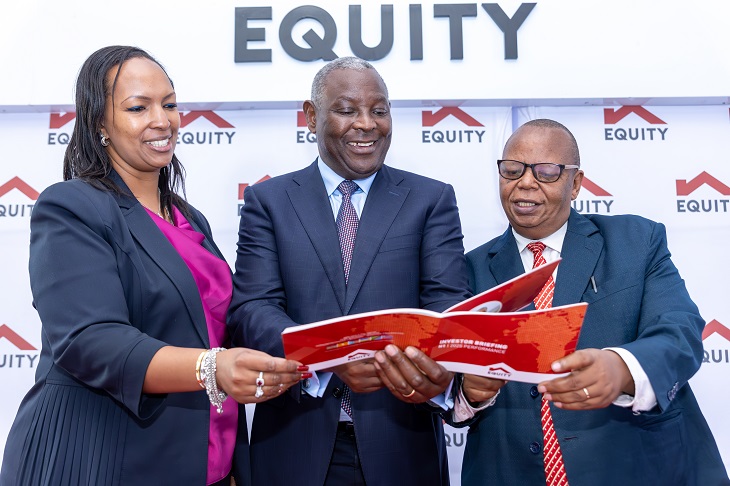Equity Group’s Pan-African growth strategy is paying off in a big way, with regional subsidiaries now contributing an impressive 46% of Group profits and 48% of assets, a strong testament to the bank’s continental ambitions.
The Democratic Republic of Congo (DRC), Uganda, and Tanzania have emerged as growth engines, while Kenya continues to anchor the Group as its headquarters and the foundation of its continental success story.
The performance underscores Equity’s evolving identity—not just as Kenya’s largest bank by market capitalization, but as a leading African financial institution whose growth story is now playing out across multiple regional economies.
Read Also: Equity Bank’s German Desk Ignites Cross-Continental Investment Momentum
The Strong Home Base In Kenya
Equity Bank Kenya remains the cornerstone of the Group’s operations, posting a 40% jump in profit after tax to KShs. 19.5 billion, up from KShs. 13.9 billion in the previous period. This growth was powered by an 18% increase in net interest income to KShs. 32.8 billion, compared to KShs. 27.7 billion last year.
The bank also benefited from a 29% drop in interest expenses to KShs. 18.3 billion, down from KShs. 25.6 billion—a reflection of prudent funding cost management.
Total equity in the Kenyan unit rose by 22%, reaching KShs. 154.6 billion from KShs. 127.2 billion, strengthening the bank’s capital base to support further lending and innovation in its home market.
The Growth Giant in DRC
Equity BCDC in the Democratic Republic of Congo has firmly established itself as a powerhouse within the Group. Profit after tax climbed 22% to KShs. 9.1 billion, up from KShs. 7.4 billion. The loan book expanded by 13% to KShs. 275.4 billion, funded in part by a redeployment of resources from cash holdings, which declined from KShs. 271.4 billion to KShs. 236.5 billion.
The subsidiary’s total equity surged by 28% to KShs. 82.6 billion from KShs. 64.8 billion, reinforcing its capacity to finance infrastructure, trade, and private sector development in one of Africa’s most resource-rich economies.
Steady and Strategic Expansion Happening in Uganda
Equity Bank Uganda delivered a 40% rise in profit after tax to KShs. 1.9 billion, up from KShs. 1.4 billion. Deposits grew by 5% to KShs. 96.8 billion, supporting an 11% increase in cash and bank balances to KShs. 25.7 billion and a 14% rise in investment securities to KShs. 36.8 billion.
Capital in the Ugandan unit increased by 9% to KShs. 16.8 billion from KShs. 15.4 billion, giving the subsidiary a solid foundation to accelerate lending and deepen financial inclusion initiatives.
Broad-Based Asset Growth in Rwanda
Equity Bank Rwanda posted 21% growth in total assets, reaching KShs. 130.1 billion from KShs. 107.6 billion. This expansion was driven by a 22% increase in deposits to KShs. 94.7 billion, a 23% surge in the loan book to KShs. 56.1 billion, and an impressive 48% jump in cash and bank balances to KShs. 42.1 billion.
Capital grew by 26% to KShs. 19.9 billion from KShs. 15.8 billion, positioning the Rwandan subsidiary to further its role in the country’s fast-modernizing financial sector.
A Pan-African Growth Engine
The performance of these regional subsidiaries reflects Equity Group’s deliberate strategy of geographic diversification and market penetration. With the DRC emerging as the Group’s largest subsidiary by asset size after Kenya, Uganda, and Rwanda contributing strong double-digit growth, the bank is successfully mitigating country-specific risks while tapping into new opportunities.
Dr. James Mwangi, Equity Group’s Managing Director and CEO, has often described the Group’s vision as “transforming Africa’s banking narrative from aid dependence to economic self-reliance.” The latest results put weight behind that vision, showing how an institution born in a small rural Kenyan town has evolved into a Pan-African force.
Positioning for Continental Leadership
Equity’s growing regional footprint also strengthens its positioning for leadership across African and international banking rankings. With nearly half of profits now coming from outside Kenya, the Group is less reliant on its home market and more embedded in the growth stories of multiple economies.
As regional economies rebound from global headwinds, Equity’s balance sheet strength—reflected in rising capital across subsidiaries—positions it to capture new opportunities in trade finance, SME lending, infrastructure financing, and digital banking innovation.
This multi-country resilience makes a compelling case for a broader narrative: Kenya as the headquarters of one of Africa’s most successful banking exports. In an era where African financial institutions are increasingly being recognized on global platforms, Equity’s story could be paired with a “Top African Bank” leadership campaign across regional and international media, cementing both its brand and its Pan-African ambition.
